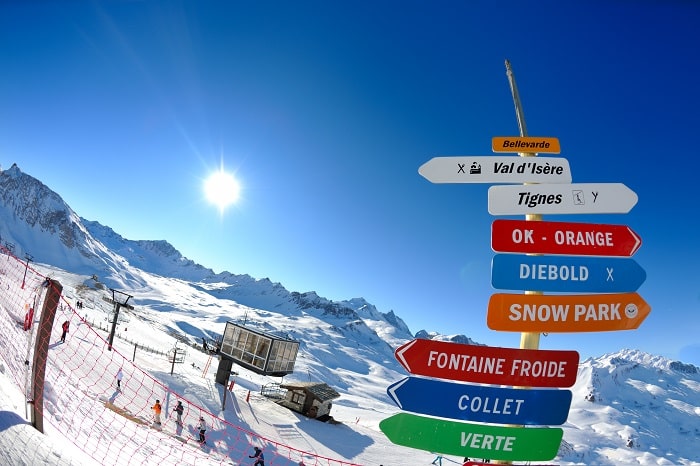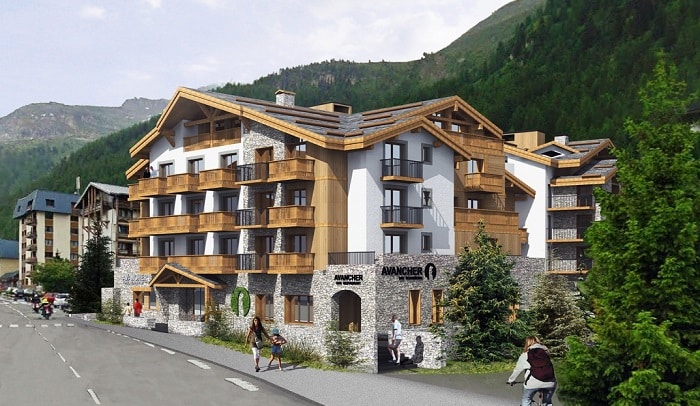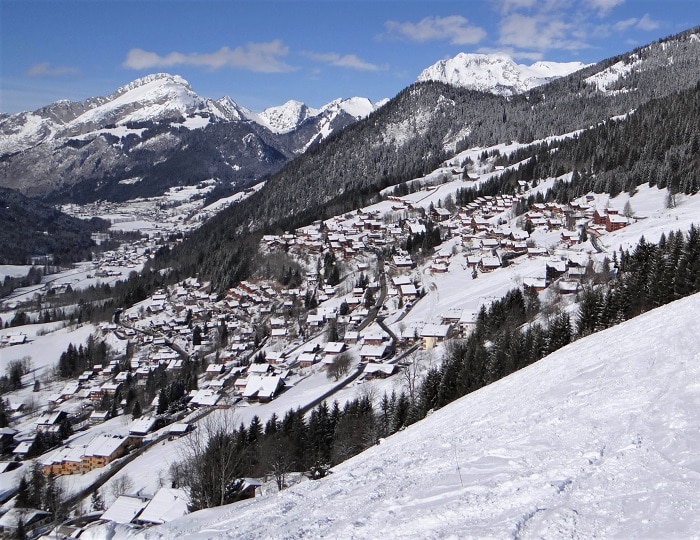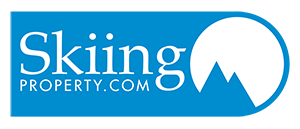Posted on 11 October 2019
Anyone looking at buying a ski rental property should consider France as their country of choice and for good reasons. The French Alps is home to the world’s largest ski area, Les 3 Vallees in the Savoie department, and figures show France is the world’s most popular place to ski. These facts make ski property an appealing investment from a rental perspective.
Les 3 Valles boasts 600 kilometres of interconnected slopes, equating to 18.5 square kilometres of groomed runs, more than any other interconnected ski area on the planet. Also, it boasts 120 kilometres of cross-country skiing and 180 lifts and is home to some of Europe’s most desirable ski resorts including Courchevel, La Tania, Méribel, Brides-les-Bains, Les Menuires, Saint Martin, Val Thorens and Orelle.

Meanwhile, according to statistics by Domaines Skiables de France, an organisation representing the French ski industry, French ski resorts average 57.9 million skier days while across the pond, USA resorts record 56.9 million skier days. The US has always held the top spot until France dethroned it.
A further study by the Great Britain Ski Club focused on the British outbound ski market, backs up this research and gives good reasons.
- The report says, over 40% of skiers from the UK fly to airports serving the Alps, including Geneva, Grenoble, and Chambery.
- Size and guaranteed snow were two reasons people chose France.
- France scores highest within Europe alongside Switzerland for skiing quality. This keeps loyal skiers with France scoring 72%.
Chatel, a typical resort is helping to improve France’s status as the number one ski destination. The improved ski lift infrastructure, linking Chatel village into the Portes du Soleil area and a sports centre facility are a few reasons, and despite its low altitude in French terms, the snow record is excellent because of its proximity on the Alp’s northwestern edge. Combined with just over an hour’s drive from Geneva Airport, for skiers looking at weekend getaways, it is an ideal base.
We’ve all known for years why skiers head to the French Alps, good snow records, large ski areas, easy access and a choice of traditional villages and modern purpose-built resorts that offer convenience. The fact it’s now the world’s number one skiing destination means we’ll see increased stability in the property market while still providing the most comprehensive choice in accommodation across the Alps’.
Buying a Ski Rental Property: Choosing France
Purchasing a property in a French ski resort could make a lucrative long-term buy-to-let. For a maximum rental potential, investors taking advantage of favourable buying conditions should choose a dual season resort with a short transfer, long winter season, good snow record and resort facilities, including school, and one linked to larger skiing areas, such as the Three Valleys, Espace Killy, Paradiski or Portes du Soleil. Ski-in ski-out properties always let best.
Buying a classic freehold ski home and letting it yourself would suit owners who desire to maximise rental income. Using a local property management agency to manage bookings and changeovers is a popular option, although owners should factor 20 percent commission of earned rental income. Aim for at least ten weeks occupancy in winter, eight in summer, or ten in year-round resorts like Chamonix.
Rental Returns: What Should Homeowners Expect?
French Alp rental property owners should know what to expect to earn from a week’s rental, and what sort of seasonal variations they can charge. For example, is it famous throughout the season? Does it have access to an enormous domain? What is the proximity to the slopes and local amenities?
Examples include a four-bedroom chalet in Tignes, seven minutes from the gondola, sleeps up to 15 and has a sauna, games rooms and all mod cons. In peak season, this could generate £4000, and drop to £3000 over Easter, Christmas, and New Year, with a further drop to £2000 in summer. Research the current market to ensure you expect in line with current travel prices and trends.
What to Look for in Ski Rental Properties
Ski-in and out: The greatest allure any property can possess is ‘ski in and out’ and overlooking a piste, rather than down a track off-piste. Otherwise, potential guests will have to either take a bus, taxi, or their car to first lifts, an inconvenience that will reduce your property’s likely income.
En-suite rooms: Each bedroom in a ski property should be en-suite. Rooms with shared bathrooms sound more downmarket and are unpopular with guests who wander down corridors late at night to visit the toilet or run around a semi-clad when it’s post-piste shower time.
Hot property: Skiers imagine the cliché of a roaring fire when they return from skiing wet and cold and expect it too from their holiday chalet or apartment.
Boot rooms: Most chalets and apartments in resorts feature a boot room for skis and boards, but many are a long walk from front doors or at the back of the property, neither of which is convenient or desirable.
Parking: Many ski chalet and apartment holiday companies’ bus in guests to a resort but, as independent travel becomes popular, increasing numbers of skiers now prefer to drive to Europe’s resorts in their cars. Therefore, properties without decent parking provision are problematical, as most resorts now feature parking wardens patrolling pay-and-display car parks and on-street bays.
Four Tips When Buying
Celebrity sightings in the French Alps reach all levels of society. However, not having the budget of a famous film or rock star means most buyers of Alpine homes rent out their property to help cover its costs, whether they own a leaseback or classic freehold property.
We estimate around eight out of ten people rent out their chalet or apartment. For private lets, some resorts and properties have better occupancy rates than others, so research your target occupancy level to decide if leaseback is best for you. Our four tips will help you decide.
1) For the maximum rental potential, buy in a dual season resort with short transfers, long season, good snow and resort facilities, like a ski school. It should also link to larger skiing areas, like the Three Valleys, Espace Killy or Portes du Soleil. Ski-in ski-out always lets best. Examples of resorts include Tignes (Espace Killy), Courchevel (Three Valleys) and Les Gets (Portes du Soleil).
2) When estimating net rental income, remember you are liable for French income tax after deduction of allowances applicable under relevant tax regulations. You must declare rental earnings to the HMRC. However, the UK/France taxation treaty gives relief for tax paid in France against UK tax so if your UK tax liability is higher than the fee payable in France; the difference is payable in the UK.
3) Many buyers take advantage of low-interest rates with French euro mortgages and receive rental income in the same currency, avoiding exposure to currency exchange rates.
4) Factor in insurance and upkeep costs. Ensure your policy covers you for rentals and associated liabilities. Meanwhile, if your property includes communal areas, you’ll have annual fees to pay, alongside the Fonciere and d’Habitation taxes.
What to Expect from a Property Management Firm
Hiring a property management firm is common, but as a new owner, how do you pick the right company, and what should you expect from them? Most management firms will offer different levels of service, with many willing to take control of generating rentals and handling bookings for you
Know what services you’re getting, the price you agree for them and ensure the firm is competent. Skiing holidays are a week, so skiers like to maximise every second in a resort, with slick changeovers. Losing a day’s skiing because of a reduced transition would not go down well with a paying guest.

A typical management firm will offer a simple key-holding and meet-and-greet service. Some also clean properties between changeovers, take care of laundry – some agencies will rent bed linen and towels to homeowners. Additional options could be welcome packs, stocking the fridge between transitions, and emergency contact numbers.
If you are looking for a firm, shop around as you’ll pay commission on bookings for this service, rather than a fixed price. Get testimonials from existing clients if you can.
Advantages and Disadvantages of Leaseback Property
In the 1980s, sale and leaseback schemes took off and these days feature in the French Alps. The idea came about for French tourist boards identifying a shortage of hotel beds in ski resorts. It gave incentives to build holiday accommodation in areas not zoned for mainstream residential properties.
Under this scheme, freehold properties are lease backed to the developers or a management company. They let them out for a specified number of weeks each year, and owners receive a guaranteed fixed rental income.
The owners can use the property during remaining weeks, and the management company handle decorating and repairs. Refunded VAT applies if leaseback durations are 20 years but most sales are for a leasing period of between nine and 11 years, so buyers more or less have to renew their deal with the developer to get the best returns.
Although this scheme isn’t for everyone, it is successful for those looking for long-term investment rather than a more traditional holiday home, and the VAT refund is a definite incentive. However it offers little flexibility and locks owners into schemes for long periods.
British Buyers Choose Leaseback
The popularity of leaseback ski properties in France increased because of growing numbers of British buyers turning their backs on outright purchases for ownership of managed apartments in residences de Tourisme, which gives them both private use and a rental income.
Typical British clients are Christine Birch (53) and her IT consultant partner Steve O’Carroll (54) who live near Horsham in West Sussex. They spent two years looking at ski-in, ski-out properties to buy outright. Then Steve read a newspaper article about a leaseback resort and went to visit.
‘‘When we found we could buy a three-bedroom apartment for the price we would have to pay for a two-bed elsewhere, we decided this was the place for us. The convenience attracted us, straight forward buying process and because they take lettings care of for us.”
Christine and Steve love the fact that there is much more than skiing on offer in their resort, Val Cenis, which is accessible all year round. So, they chose a leaseback scheme which gives them four weeks of personal use of their apartment – two in winter and two in summer. They can also use their property for an extra 28 days a year when the spa and other residential facilities close for annual maintenance.
These include part of summer when temperatures can reach as much as 40 degrees Celsius. Activities on offer include tennis, archery, mini-golf, kayaking and pony riding. Hikers, bikers and horse-riders can discover quiet valley roads, mountain paths and undulating vineyards and lakeside scenery and breath-taking alpine panoramas.

Christine and Steve enjoy their property during the most popular periods, at the height of the ski season, including Christmas, New Year, Easter and half-term without losing out. This is because they pay guaranteed annual rental income to owners twice a year.
“It not only covers all the running costs but, at the end of each year, we have a few thousand extra euros in our pockets,” concluded Christine.
Call us if you want more information or to ask questions about buying a ski rental property. Otherwise, see our portfolio of apartments and chalets for sale here and just use the contact details for more information on any of them. Our blog archives, also gives plenty more advice and tips for property buyers in the Alps.

